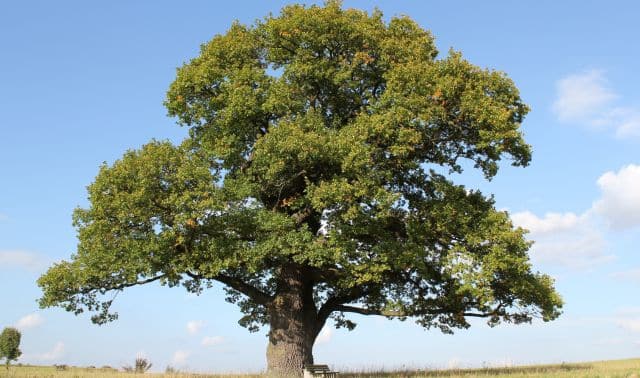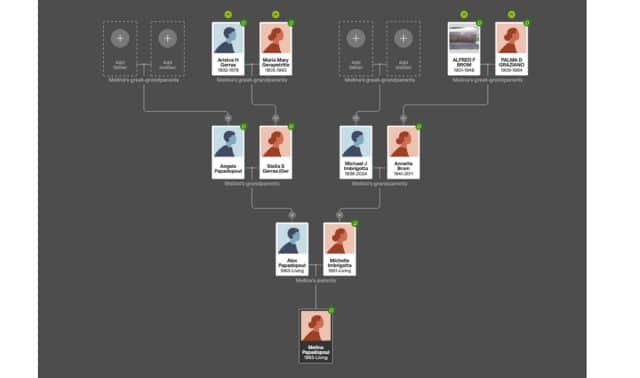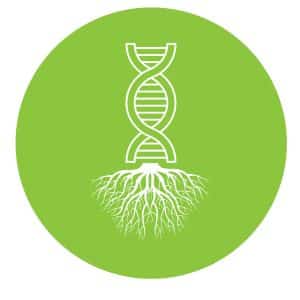Sign up for the Family Tree Newsletter! Plus, you’ll receive our 10 Essential Genealogy Research Forms PDF as a special thank you.
Get Your Free Genealogy Forms
"*" indicates required fields
Table of Contents
When you plant a tree, you don’t expect it to sprout overnight. That seedling will require years of rain, sunshine and care before it blossoms into a sturdy sycamore that offers cool shade and generous foliage. As it turns out, your family tree and family history research aren’t much different. You are unlikely to end up with a family tree that spans many, many generations in a single day. It can take awhile to research and uncover the mysteries of your ancestors.
But just like planting an actual tree, just because it takes time doesn’t mean it’s not worth doing. This guide will take you from the very start of your researching family tree—that small seed—all the way to the impressive, sprawling tree that balances your legacy on its many branches!
1. Planting the Seed: Start With What You Know
A tree doesn’t begin from nothing. You need that first little seed to grow something beautiful. Below we offer tips for beginning your family tree research.
Where Should I Begin My Family Tree Research?
Sometimes it is easy to think of research as little more than opening some books, taking notes, writing things down and then repeating the process again and again. While this can be part of it, genealogy research tends to involve more than that. After all, you aren’t just researching people who lived many, many years ago. You are researching your ancestors. As such, you aren’t just dealing with old books that state dry facts about people you’ve never met. You are scouring records, talking with others, hopefully making family tree discoveries in the process. Getting started can be tricky, but there are steps you can take to ease into the process, such as:
- Record Family Stories and Lore: Family stories are more than just fascinating tales to share at the dinner table on Thanksgiving; they also can reveal critical details about your ancestors and where they came from. Set those stories on paper so that you can readily reference them as needed. You can be as creative as you desire in the process. If you can’t think of any stories to unravel, there are many resources you can explore.
- Talk to Family Members: Sometimes, the best information comes not from dense records or dusty documents but directly from the people you know best: your family. Consider sitting down with a relative and conducting an interview. Ask a range of different questions that are likely to yield the answers you seek. For example, you’ll want to avoid questions that require little more than a shake or nod of the head. Instead, ask about their childhood, family traditions, other relatives, names in the family, family stories they have heard over the years. You might even ask them to bring photos or heirlooms if they have any.
- Come Up With a Research Plan: Ask yourself what you wish to accomplish from your research. Are you just looking to build your family tree, or is there a specific ancestor you want to know more about? Write down your goal to make it real for yourself and then come up with a concrete plan for researching your goals. If you’re not sure what that plan should look like, break down your goal and ask yourself honestly what information and tools you need to achieve it.
2. Find Nourishing Soil: Build Your First Family Tree
Once you have begun your research, you may be ready to build your very first family tree. Below are some steps to guide you through the process, as well as some tools that you may find helpful.
How Do I Fill Out a Family Tree?
Before jumping right into the technology and other complexities that might come with researching your family tree, you might want to step back and begin with a basic task: filling out a family tree template. Here are some tips to help you:
When building your family tree, you don’t have to dive too deep into research just yet. You can begin your search for answers with what you already know—yourself. You might write down your name, as well as your birth date, year and place of birth, depending on the template or type of tree you are using. Then, move on to the people you might know second best: your parents, and then your grandparents—you get the idea. Be sure to write out your dates in the same format throughout your entire tree. The standard convention is: day, month, full year. You should also write the month abbreviation as opposed to the numeral associated with the month. For example, May 5, 1945 would be written out as 5 May 1945.
Where Can I Build My Family Tree?
Once you have begun gathering basic information about your ancestors, you may want to decide where to root your family tree. This place serve as the “home” for your family tree, where it is given the chance to grow and thrive as you add to it. Depending on the platform you choose, you might also use it to store important research, photos and other materials.
The Big Four Websites
Ancestry.com—Arguably the “king” amongst the family tree websites, Ancestry.com gives its members plenty to work with. Search millions of public family trees and peruse billions of records that span decades and continents. You can also find a subscription plan that matches your needs and budget.
FamilySearch—Based in Salt Lake City, Utah, and run by The Church of Jesus Christ of Latter-day Saints, FamilySearch boasts a perk that not many other digital platforms listed here do: It is completely free! Not only can you build your family tree, you can also access countless records and search billions of names.
FindMyPast—FindMyPast may be based in the United Kingdom and specialize mainly in British and Irish records but that doesn’t mean that you won’t find valuable information and tools as a US-based genealogist hoping to find your ancestors. You will find a good number of records covering North America and beyond.
MyHeritage—With over 6 billion profiles and 50 million family trees, MyHeritage is hard to overlook. You’ll also find an impressive collection of records to fill out your family history research. You can even bring your family tree to life with photos, stories and other materials!
Family Tree Software
While the major family tree websites, and those like them, are excellent for researching your family history and finding matches that might have otherwise evaded you, they may come with some limitations. For example, many of the paid options give you access to their features only as long as you are subscribed, and you may not always want to or be able to pay the fee. Some people may also be reluctant to provide their information to a big website. In such cases, a family tree software program may be a better fit, or it can be used in conjunction with your online tree.
There are many different family tree software programs available today, and the right one for you may depend upon your preferences and goals. Below are some of the most popular family tree software:
Ancestral Quest (Mac and Windows)
Highlights: Ancestral Quest allows users to build their family trees and to cite their sources easily. The software can also aid you in your research, as it scans over 30 billion records. You can also use the scrapbook feature to highlight special memories.
Family Tree Maker (Mac and Windows)
Highlights: The software’s latest version, Family Tree Maker 2019, offers many valuable features. Its “Turn Back Time” keeps a detailed log of every change you’ve made to your tree. This feature is perfect for restoring changes that you wish to recover or for correcting mistakes without losing all of your valuable data thus far. Like many programs, you can add photos to your family tree. But Family Tree Maker takes it a step further by allowing you to crop photos for a sleeker look.
Legacy Family Tree (Windows)
Highlights: Legacy Family Tree boasts over 100 reports and charts in different styles and formats so that you can choose the one that best represents your family tree. It also scours the Big Four—Ancestry.com, FamilySearch, Findmypast, MyHeritage—for crucial information that you may be missing, including photos. Finally, its SourceWriter helps you create clean, accurate citations for your sources. Legacy Family Tree is first and foremost a Windows program; however, it is possible to use on Mac by following some steps. Best of all? It is now free!
Reunion (Mac)
Highlights: Reunion offers many features that promote efficiency while building your family tree. For example, its “shared” source record feature requires you to enter a record’s details one time. Once it’s there, you can attribute the source as often as you desire without typing in all the same information again. It also remembers the surnames that you use most frequently so that you don’t have to retype the same information again and again. Finally, Reunions easily integrates with Google Maps to highlight place names that you have entered, which may include birth and death places, residences and more.
RootsMagic (Windows and Mac)
Highlights: Worried about pesky errors and inconsistencies in your family tree? RootsMagic’s “Problem Alert” feature flags potentially erroneous data so that you can review it and act accordingly. Likewise, the DataClean tool can identify issues with place and people names and correct them on the spot. You can also work with multiple trees at one time and drag and drop one to another seamlessly.
Which Family Tree Website or Platform Is the Best?
Now that you know what tools are at your disposal for building your family tree, you may feel overwhelmed by your options. You may wonder which of the “Big Four” comes out on top and whether you should try a family tree software or just stick with an online tree. Ultimately, however the, right family tree website, software or method for you may depend upon a few key factors:
- Your Comfort With Technology: Many of the most popular tools can be accessed right from your phone or computer, which is certainly convenient. That said, if you do not access such technology frequently or have much experience with it, building a family tree with software can feel intimidating. Fortunately, with some practice, many of the “Big Four” can be welcoming to beginners.
- The Device You Use: This factor especially comes into play if you wish to use family tree software, as some programs may not be compatible with your system. For example, Legacy Family Tree is primarily a Windows-based software, while Reunions runs only on Macs. You will want to read the software system requirements carefully to ensure that yours qualifies.
- Cost: Many of the paid genealogy tools offer undeniable benefits and features that make building your family tree easier. Unfortunately, they can be expensive, especially if you have subscriptions to multiple services. You may consider making a genealogy budget to determine what you are willing and able to spend on the project (and any future projects). Keep in mind that all of the Big Four do offer free trials and limited features to nonsubscribers, and FamilySearch is free to use.
- Your Overall Genealogy Goals: While it may be tempting to jump right into subscribing to all of the shiny programs, you might want to take a moment and ask yourself: What do you wish to accomplish in building your family tree? Perhaps you dream of planting a family tree whose branches sprawl for generations—or maybe you just want something functional and visually pleasing to share with the grandchildren. In any case, it helps to see what your goals will require first.
3. Water and Prune: Research Records
You have begun building your family tree and have already knocked out the obvious answers to your genealogical queries. Now you find yourself staring at blank spaces and maybe even asking more questions and wondering where to go next. This is where genealogical research comes into play, perhaps one of the most rewarding aspects of building your family tree. Nonetheless, the word “research” can strike fear into some hearts, as it invokes memories of academic papers and long evenings spent at the library.
Family tree research does not have to be scary, however! You can break the process down into more manageable steps and proceed at your own pace. Below are tips and resources to guide you through this exciting genealogical journey.
Types of Genealogical Records and How to Find Them
Records can reveal crucial details about your ancestors. Finding them, however, can be challenging, especially if you aren’t sure what you should be looking for. Below we break down some of the most valuable record types to genealogists, what they entail and what they can tell you about your ancestors.

Vital Records: Birth, marriage and death—these are all facts of life. Like many things, they also result in paperwork, and your ancestors’ key life events were no exception. You can glean a lot of information from these vital records. Birth records can tell you where your ancestor was born, when they were born, who their parents were and their ages, their mother’s maiden name, their religious affiliation and so much more. You might also look for baptism and christening records. For ancestors who have been married, you won’t want to skip out on marriage records. They will often reveal both the names of the bride and the groom and where they were married. Some marriage records may also include where the bride and groom live, the names of their parents, their occupations and whether they have been previously widowed or divorced. Beyond this, marriage records may entail marriage certificates licenses and returns, declarations of intention, bonds, annulment, consent affidavits and divorce records. Finally, death and burial records can tell you where your ancestor died; their cause of death; whether they were married, divorced or widowed; where they were laid to rest; and so much more. Death records may include death certificates and registers, cemetery records, burial permits and obituaries.
Census Records: Every ten years, the United States takes a census of its population. Since the first official census in 1790, these censuses have generated key information about individuals (although they have grown much more informative with time)—information that is crucial to you as a genealogist. You may find answers such as: where your ancestors have lived, what did they do for work, with whom they lived, whether they were married or divorced, how many children they had.

Church Records: Over the years, churches have served as more than places of worship. They have been social hubs, community support and so much more. With so much going on beneath those steeples, paper trails have resulted, meaning plenty of documents to sort through. These documents entail more than just membership lists. Your ancestors likely were baptized at their churches, which means baptism registers. They also experienced other life milestones, such as marriages and, as grim as it may be, funerals. This means that you may find marriage and burial records as well.

Court Records: It’s hard not to associate the courtroom with legal documents. As it turns out, beneath the dense legal terms lies information about your ancestors that can potentially lead to meaningful genealogical discoveries. Court room documents may include wills, guardianship records, estate records and court case documents.

Immigration Records: Your immigrant ancestors endured a lot to arrive in the United States or other country—including a good deal of paperwork, in many cases. Immigration records can reveal much about their journey, including where they came from and where they settled. Ellis Island records, passenger lists, alien registrations, naturalization records, internment camp files and passport applications are all examples of records that can tell the story of your ancestors’ journey to a new life.

Land Records: Your ancestors had to live somewhere. Whether they lived in one modest home for most of their life or owned lots of land and property, they probably paid taxes on it, meaning plenty of tax records to glean. But tax records aren’t the only land records you should be looking for. Land records might also entail patents, deeds and historical maps.

Military Records: If you have an ancestor who served in the military, you may be in luck. Their service may do more than fill you with a sense of patriotic pride, it might also point you toward some real family tree discoveries. You might search for conflict-specific records, such as records from the Revolutionary War, War of 1812 and World Wars I and II, or you might focus on muster rolls, draft records and pension records.
Tips for Records Research
- Visit a Library: You might be surprised by the information you can find at a library—and you don’t have to travel to Salt Lake City to the FamilySearch Library to get answers. Even your local library can have records, books, photos, city directories and other.
- Make Record Requests: Are your own searches not turning up the records you seek? Do not despair. You may be able to request certain records from the agencies that oversee them. The process for obtaining records will depend upon the record type you seek. For example, you may have to undergo one process for federal records but a whole different process for more local records. Fortunately, there are request templates you can use to make the process less intimidating.
- Verify Hints and Info from Other Trees: In that moment of excitement, it can be tempting to accept every family tree hint that comes your way. But you will want to take a moment to ask yourself a few questions and review all the facts carefully. It may take time, but it is better to have an accurate tree than one with many dubious claims.
- Manage Your Sources: Don’t discard those sources soon after you skim from them the information you seek. Cite them so that you can always access them and refer back to them as needed. Have paper records, letters and other materials you aren’t sure what to do with? Consider digitizing them so that they can live in a safe place for years to come.
4. Delve Into Roots: Take a DNA Test
So far, our focus on building the family tree has remained above-surface, the things we can easily see: a beautifully designed family tree template, a carefully curated collection of records. But some valuable hints go unseen below the surface, within you right now—that’s your DNA.
Your DNA makes you who you are. It also can tell the stories of many who have come before you. Below we touch upon using DNA to build your family tree.
Understanding Your DNA Test Options
Today, there are many different DNA testing companies to choose from, to the point it can be challenging to choose the right one. Some of the better-known DNA tests include:
Before deciding on a DNA test, you might consider reading reviews and comparisons of the various popular tests. Consider what you want to learn from your DNA test and compare your goals with what each test offers.
What DNA Can Tell You
- Places to Research: Thanks to the location and communities reports that the major DNA testing companies provide, you can get a good idea of where your ancestors might have lived at some point in time. You can use these reports to point you toward new places to find records that may contain information about your ancestors.
- Ethnicity Estimates: The ethnicity estimates from your DNA test may not surprise you overall. But if you notice anything that is at least a little unexpected, you may consider zeroing in on it. For example, you might not have expected to see any hints of Scandinavian heritage in your report, but a small percentage shows up. Even if the percentage is small overall, it can help you generate new research questions that lead to meaningful family tree discoveries.
- Shared DNA Matches: You can determine how closely you are related to someone. The chart featured here can guide you and you determine your relationship.
What DNA CANNOT Tell You
- When Your Ancestors Lived in Any One Place: You won’t be able to tell for certain when or for long your ancestors lived in a certain region of the world. Changes in migration patterns might have happened over the course of many years.
- Definitive Ethnicity: You should keep in mind that the estimates are just that—estimates. They do not define you in any one particular way.
- Whether You Will Definitively Inherit Certain Conditions and Illnesses: Many of the big DNA companies offer health tests to help you determine what illnesses might run in your family. These can be great tools for helping you maintain your health and understand what you may be up against
—but they can by no means predict whether or not you will absolutely develop the conditions tested for. It’s important to understand that health is nuanced and can depend upon many factors, including environmental and behavioral. Keep this in mind when reviewing the data.
5. Admire the Flowers: Share Your Research
You’ve come so far with building your family tree! But a genealogist’s job is never truly done. Like a real tree, your family tree wants to be maintained so that it can flower. Below are some final tips on what to watch out for as you can continue to grow your family tree bigger and stronger.
Print Family Trees
While the convenience of creating and maintaining an online tree can’t be denied, sometimes you still want a physical tree that you can hang up on the wall, show off at family reunions or gatherings, or just pore over and study at your desk. Fortunately, print family trees can satisfy these needs, and you can often find them in the same places you keep your digital tree. For example, the Big Four websites and most family tree software offer options for printing your family tree. If you desire something more elegant looking, you can seek out family tree printing services.
Sharing Your Tree Online
Technology makes it easier than ever to share your tree with just a few clicks. Here are some ways that you can invite others to view your tree and even contribute to it:
- Invite Others on the Big Four: Ancestry.com, FamilySearch, Findmypast and MyHeritage all allow users to share links to their trees so that others may view your tree and add information to help build it stronger. Each website has its own process for doing this. Generally speaking, you simply need to invite specific users or send them a link.
- Contribute to a Community Tree Website: If you want to share your family tree research with a wider audience, consider contributing to a large community tree where anyone can share. Examples include WikiTree, WeRelate and Geni.
- Start Your Own Family Tree Website: Want your own place to share your research, write down your thoughts and boast about wonderful family discoveries? Consider creating your own website. You can share more than just tree information. You can also share family stories, photos and more.























